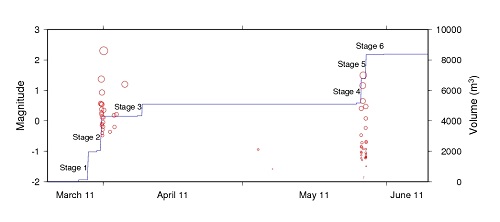Hydraulic Fracturing and Induced Seismicity
- Firstly, the injection of fluids under high pressure generates new cracks and fractures in a previously intact rock mass. As these grow and spread they are accompanied by brittle failure of the rock and corresponding microseismic events. These are sometimes referred to as "fracked" events. The size of these "fracked" events is constrained by the energy of the injection process.
- Secondly, both presence of high pressure fluid and the stress perturbation caused by the fluid can change the effective stress on pre-existing faults, causing them to fail. These events are sometimes referred to as "triggered" events. Since small stress perturbations can cause relatively large earthquakes the size of these events depends largely on the amount of stored up elastic strain energy already in the rocks.
Possible Hazard
The general consensus among most authors is that the process of hydraulic fracturing a well as presently implemented for shale gas recovery does not pose a high risk for inducing either felt, damaging or destructive earthquakes, e.g. U.S. National Research Council report. Experience in the U.S., where many thousands of stimulations have been carried out suggest that the magnitudes of the induced earthquakes in reservoirs such as the Barnett and Marcellus Shales are typically less than 1 Mw. It is important to note that most sites of unconventional gas operations lack independent instrumentation for monitoring induced seismicity and that earthquakes with magnitudes of 2.5 or less will fall below the detection thresholds of regional seismic monitoring networks. Earthquakes of this size are unlikely to be felt or even detected unless local seismic monitoring networks are in place.
Potential for Larger Earthquakes
However, there are documented examples of earthquakes with magnitudes greater than two that have been conclusively linked to hydraulic fracturing for shale gas exploration/recovery. In the Etsho and Tattoo fields in Horn River, Canada, 216 earthquakes were detected during between 2009 and 2011 (BC Oil and Gas Commission, 2012). Twenty-one of these earthquakes had magnitudes of 3.0 or greater, and the largest event had a magnitude of 3.8 ML. In the Eola Field, Garvin County, Oklahoma, 86 earthquakes were detected during hydraulic fracturing in 2011 with magnitudes up to 2.9 ML (Holland, 2013). In July and August 2014, earthquakes with magnitudes of 4.0 and 4.2 occurred near Fort St. John, British Columbia, Canada. Both earthquakes are considered to have been induced by hydraulic fracturing activities in the region (Atkinson et al, 2015).In Lancashire, UK, 58 earthquakes were linked to fluid injection during hydraulic fracturing at the Preese Hall well in 2011 (de Pater and Baisch, 2011). The largest had a magnitude of 2.3 ML and was felt locally. These hydraulic fracture treatments were carried out during exploration of a shale gas reservoir in the Bowland basin, Lancashire. As a result of the earthquakes, operations were suspended at Preese Hall.

Despite these examples of earthquakes induced by hydraulic fracturing, the process appears to pose a low risk of inducing destructive earthquakes. A report by the National Research Council in the U.S., which examined the scale, scope and consequences of seismicity induced during fluid injection and withdrawal related to energy technologies, concluded that the process of hydraulic fracturing a well as presently implemented for shale gas recovery does not pose a high risk for inducing felt seismic events. A review of the risks associated with hydraulic fracturing during shale gas exploration and production by the Royal Society and Royal Academy of Engineering in 2012 concluded that the surface impacts of any seismicity induced by hydraulic fracturing would be negligible. A report commissioned by the Department of Energy and Climate Change in the UK by Green et al (2012) set out a number of recommendations for the mitigation of seismic risk in future hydraulic fracture operations for shale gas. Some of these recommendations were adopted as part of the regulatory framework for future operations.
Regulation in the UK
The regulatory roadmap published by DECC provides an indicative overview of the permitting and permissions process for exploratory work in oil and gas development, onshore in the UK, and aims to help operators understand the regulation process for onshore oil and gas (shale gas) exploration in the UK. This includes specific measures for the mitigation of induced seismicity. As a result any operators using hydraulic fracturing are required to:
- Use all available geological information to assess the location of faults before wells are drilled to avoid hydraulically fracturing near faults.
- Use British Geological Survey records to assess baseline levels for seismic activity (vibrations of the Earth’s crust).
- Inject as little fluid as necessary into the rock during fracturing.
- Monitor seismic activity during and after fracturing.
- Adopt a "traffic light" system that controls whether injection can proceed or not, based on that seismic activity.
References
Atkinson, G., Assatourians, K., Cheadle, B. and Greig, W. 2015. Ground Motions from Three Recent Earthquakes in Western Alberta and Northeastern British Columbia and Their Implications for Induced Seismicity Hazard in Eastern Regions, Seismological Research Letters, 86, 3, 1-10
de Pater, H. & Baisch, S. 2011. Geomechanical Study of Bowland Shale Seismicity, Synthesis Report
Holland, A. 2013. Earthquakes triggered by hydraulic fracturing in South-Central Oklahoma, Bull. Seismol. Soc. Am., 103, 3, 1784-1792.
Majer E.L., Baria R, Stark M, Oates S., Bommer J., Smith B. and Asanuma H. 2007. Induced seismicity associated with Enhanced Geothermal Systems, Geothermics, 36, 3, 185-222 (2007)
National Research Council, 2012. Induced seismicity potential in energy technologies, National Academies Press (available at http://www.nap.edu/catalog.php?record_id=13355).
- BGS Environmental Baseline Monitoring
- Government guidance on fracking: developing shale oil and gas in the UK
- Royal Society and Royal Academy of Engineering review of the risks associated with hydraulic fracturing during shale gas exploration and production
- National Research Council, 2012. Induced seismicity potential in energy technologies, National Academies Press
- Seismological Research Letters: Special Issue on Injection-Induced Seismicity.
- British Geological Survey Shale Gas Project


